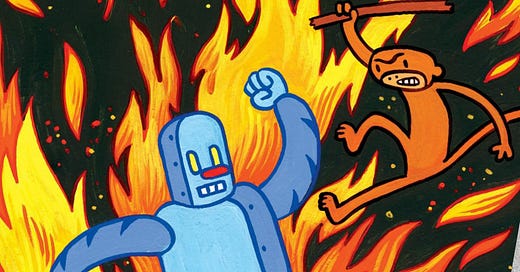Inspiration can come from anywhere - sometimes in the most unexpected forms.
Monkey vs. Robot is proof of that idea. On the surface, it’s a simple, wordless graphic novel about monkeys and robots locked in conflict. But beneath its quirky illustrations lies a story with profound philosophical depth, showing how great storytelling can communicate deep messages without the need for direct explanation - or even words.
It’s a reminder that inspiration doesn’t have to be loud or obvious. Sometimes, it’s the quiet, visual stories that resonate the most, leaving space for us to interpret, reflect and draw our own meaning.
The Discovery
I stumbled across Monkey vs. Robot almost by chance during a trip to Byron Bay. It wasn’t a planned purchase - I was drawn in by the cover, its bold simplicity standing out on the shelf. At first glance, it seemed quirky and lighthearted, something I could flick through.
But what stayed with me wasn’t just the charm of the illustrations or the playful premise. There was something about the book that resonated on a deeper level, even if I didn’t fully realise it at the time. I never expected an almost wordless graphic novel to provoke so much reflection about the world we live in - or about the way I think, work, and move through life.
The Book
On the surface, Monkey vs. Robot tells the story of two opposing worlds colliding. The plot is simple: monkeys live in harmony with nature, while robots toil in a factory, producing goods they neither use nor need. When their paths inevitably cross, a conflict arises, exposing their fundamental differences and shared vulnerabilities.
Through minimal dialogue and a stripped-back narrative, James Kochalka tells a story that feels universal. The monkey and robot become archetypes, representing not just nature versus technology but something deeper - intuition versus logic, or perhaps the past versus the future.
The beauty of the book lies in its simplicity. With little dialogue, the illustrations do all the heavy lifting, creating a meditative experience for the reader. The lack of words invites you to interpret the expressions, the movements and the quiet spaces in between. It’s a story that asks for patience and reflection, rewarding you with insights that go beyond the page.
The Inspiration
As I read and re-read Monkey vs. Robot, I couldn’t help but see parallels to our modern world. The monkey feels like a stand-in for humanity—the part of us that’s tied to intuition, emotion and a deep connection to the natural world. The robot, on the other hand, represents the march of technology, logic and progress. These two forces are in constant tension, pulling us in different directions.
For me, this tension often plays out as a battle between the familiar comfort of the past and the seductive pull of the future. The monkey clings to what’s organic, raw, and real, while the robot pushes us toward efficiency, innovation, and perfection. Both are right in their own ways, and both are deeply flawed. What the story reminds me, though, is that in focusing too much on either the past or the future, we risk losing the present altogether.
This idea resonates in my work and in my personal life, where I often explore the interplay between rationality and emotion, structure and spontaneity. It’s easy to get caught up in building systems, perfecting processes, or chasing progress, but Monkey vs. Robot reminds me that there’s power in simplicity - in stepping back, observing, and appreciating what’s in front of us.
The parallels for general modern life are there, but as 2024 draws to a close maybe there are a lot of parallels playing out right now in politics, remote work, AI and other areas of life.
The Take Out
The brilliance of Monkey vs. Robot lies in how it strips complex ideas down to their essence. By paring back the narrative and relying on visual storytelling, it creates space for the reader to fill in the gaps. That act of interpretation becomes part of the experience, forcing us to confront our own biases, assumptions and philosophies.
What I’ve taken from this book is the importance of balance. The monkey and the robot aren’t just fighting each other - they’re each fighting for relevance, for survival. And in many ways, we’re doing the same. How do we balance progress with tradition? How do we embrace technology without losing sight of what makes us human? These are questions I come back to often, both in my personal life and in my work.
Perhaps the most profound takeaway is that maybe instead of focussing too much on the past, or too much on the future, we need to remember to live more in the moment. The past can teach us, and the future can inspire us, but the present is where life happens.
Conclusion
Monkey vs Robot may look like a quirky illustrated novel, but it’s a deeply philosophical meditation on the tensions we all navigate. Through its simplicity, it challenges us to step back and think about how we’re living - are we too focused on the past, too driven by the future, or are we truly here, in the present?
As the year comes to a close, this is a perfect time to pause and reflect. What lessons can we take from the year behind us? What possibilities does the future hold? And how can we be more present in our everyday lives? Over the holiday period, I’m definitely going to be re-reading Monkey vs. Robot and taking some time to reflect.
Written by Russell.






